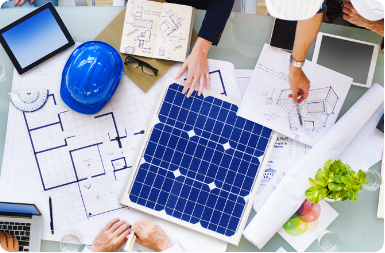Step into the world of solar energy, where the sun’s abundant rays are transformed into electricity, providing a sustainable and luxurious way of living.
Whether you’re a curious enthusiast or considering installing a solar energy system, this blog will equip you with the knowledge you need on your journey toward a greener and healthier lifestyle.
The Basics of Solar Photovoltaic (PV) Technology
Solar photovoltaic (PV) technology lies at the heart of harnessing solar energy. It implicates using solar panels, which are made up of photovoltaic cells. These cells convert sunlight into electricity through a process called the photovoltaic effect.
When sunlight hits the solar panels, the photons excite the electrons in the cells, generating an electric current. This direct current (DC) is converted into alternating current (AC) through an inverter, making it suitable for powering our homes and businesses.
Sunlight to Electricity: The Photovoltaic Effect
The photovoltaic effect occurs within the photovoltaic cells of solar panels. These cells are made of semiconductors, typically silicon, with unique electrical properties.
When sunlight, composed of photons, strikes the surface of the solar panel, it excites the electrons in the semiconductor material, causing them to break free from their atoms. This generates a flow of electrons, creating an electric current.
The more sunlight that reaches the solar panels, the greater the number of electrons set in motion, resulting in increased electricity generation.
Components of a Solar Energy System
A solar energy system has several essential components that combine seamlessly to harness and utilize solar power. The key elements include solar panels, an inverter, batteries (optional), and a metering system.
Solar panels capture sunlight and convert it into electricity, while the inverter converts the direct current (DC) into alternating current (AC), which is compatible with our electrical appliances. Batteries, if included, store excess energy for later use.
The metering system tracks the electricity generated and consumed, allowing you to monitor your energy usage and savings.
Step-by-Step Conversion Process
The conversion process of solar energy can be broken down into several steps. First, sunlight is captured by solar panels, which are strategically placed to maximize exposure to the sun.
The photovoltaic cells within the panels then convert the sunlight into direct current (DC) electricity. This DC electricity is sent to the inverter, transforming it into alternating current (AC).
Understanding Alternating Current (AC)
AC electricity can power our homes and businesses or be fed into the electrical grid. Finally, a metering system measures the electricity generated and consumed, giving you valuable insights into your energy usage.
Installation and Maintenance of Solar Energy Systems
The installation of a solar energy system requires careful planning and expertise. It involves selecting the optimal location for the solar panels, ensuring they receive maximum sunlight throughout the day.
This includes cleaning the panels, checking connections, and monitoring the energy production. With proper installation and maintenance, your solar energy system will continue to provide you with clean and abundant electricity for years to come.
Conclusion
Discover the power of clean energy with Solis Solar. Visit Solis Solar to learn how we can help you harness sunlight and convert it into sustainable electricity for your home.

